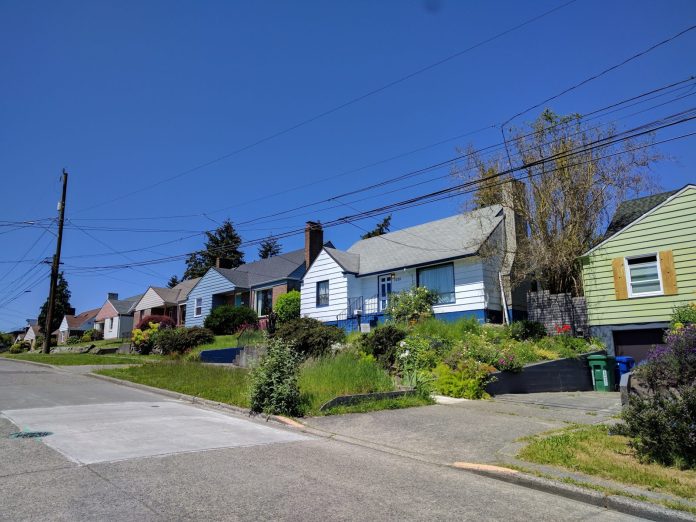During every election cycle The Urbanist asks candidates about their support for changing current single-family zones. This year, every candidate for council except for Pat Murakami, and every candidate for mayor except for Jenny Durkan, voiced support for legalizing more dense housing types in single-family zones. Since this is a top priority for many urbanists, the near consensus is encouraging.
Yet this change still feels far away. A missed opportunity in 2015 illustrated the obstacles. After receiving pressure from Councilmember Mike O’Brien to produce more affordable housing, ex-mayor Ed Murray convened housing experts to discuss a comprehensive package. The package included changes to single-family zones. This particular proposal was leaked to Danny Westneat at The Seattle Times who broke a story titled “Get Rid Of Single Family Zoning? These Discussion Should Be Secret.” Despite the modest changes, you could almost feel the wet froth from the outraged backlash. Many self-described YIMBYs and urbanists pinned the blame on NIMBYs. The Urbanist at the time criticized Westneat’s framing but also called on electeds to bring this debate to the public and develop a real plan. We’re still waiting for that plan.
The are some lessons to be learned from this experience but before highlighting those, it’s worth reviewing why single-family zoning changes are so important.
Single-Family Zoning Changes Are Critical To Achieve Urbanist Goals
People come to urbanism for different reasons and have different priorities. However, underlying this political and social movement is a belief in the value of cities. Or put another way, urbanists believe in the value of more densely populated areas. This doesn’t mean more density is always better but is a general principle; high density offers huge benefits over low density.
Single-family zoning is low density so it seems logical it would be a primary target for urbanists. Single-family zoning is also associated with a long list of problems:
- It prohibits commercial uses that form the foundation of walkable communities.
- It was often originally established to make neighborhoods unaffordable for non-whites.
- It makes new construction less affordable and inaccessible to renters.
- It limits easy access to valuable resources like schools and parks.
- It results in McMansions and completely unaffordable new construction.
- It creates weird, inequitable outcomes among neighbors.
- Many other housing types already exist in single-family zones.
- It accelerates and increases disruptions in areas that allow growth.
- It’s an obstacle to small, local businesses like corner stores.
This list of problems could easily be expanded. Additionally, single-family zoning advantages can usually be provided in ways that don’t limit density. Perhaps most importantly though, a debate over single-family zoning puts urbanists on favorable terrain. We aren’t debating minutiae of administrative processes or subjective design. Instead, we’re centering the debate on the most restrictive rules limiting density and talking about the value of density–one of urbanism’s most core values.
How To Make This Dream A Reality
Lessons from 2015 should guide the path forward. First, ex-mayor Ed Murray never showed political desire to actively pursue changes to single-family zones. It should be unsurprising he didn’t stand up to the political backlash. Second, we need to initiate a public process–not a private committee–that engages communities in how this change will be implemented.
At the end of this election cycle we will have at least one new councilmember and a new mayor. They will be entering office as mandatory housing affordability upzones are wrapping up. This will bring an opportunity to put energy into new solutions. Urbanists should demand changes to single-family zones as a top housing priority. This effort may seem like a longshot but most residents don’t live in single-family zones and it appears a majority of Seattleites would support multifamily housing in single-family zones.
Below are some strategies for achieving meaningful change to single-family zones.
Make Single Family Zoning A Top Priority: Urbanists are a diverse group with diverse interests. However, variety is the enemy of clarity. Urbanists need two or three top priorities to send a clear message and politicians can be measured by their progress. Single-family zoning changes should be one of those top priorities.
Focus On Politicians, Not NIMBYs: It appears a majority of Seattle supports multifamily housing in single-family zones. Urbanists should continue talking about the benefits with people involved in the normal land use debates. However, political leadership on this issue is key. Urbanists should ensure candidates for office cannot get through an election without clearly and explicitly stating where they stand. Silence and waffling is worse than outright opposition. Once in office, political discussion about housing should include a discussion about changes to single-family zoning.
Support Policies That Can Build A Winning Coalition: Single-family zoning changes will require a coalition. Urbanists should think about how this policy can fit into other policies that broaden the coalition. There are two obvious policies to couple with upzones: impact fees and inclusionary zoning requirements. These policies would address concerns about infrastructure, improve equity, capture value created from upzoning, build allies, and fight the perception that urbanists are developer shills. Lastly, advocating for these changes in a way that builds a coalition means we shouldn’t spend a lot of energy impugning other groups’ priorities.
We can make this change a reality. In fact, this election may be the decisive one if urbanists make changing single-family zoning a priority.

Owen Pickford
Owen is a solutions engineer for a software company. He has an amateur interest in urban policy, focusing on housing. His primary mode is a bicycle but isn't ashamed of riding down the hill and taking the bus back up. Feel free to tweet at him: @pickovven.

